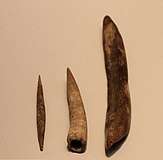Last Glacial Maximum refugia
Last Glacial Maximum refugia were places where humans, and also other species, survived during the last glacial period in the northern hemisphere, around 25,000 to 20,000 years ago.

Sub-Saharan Africa and Australia were not affected by the glaciation (although vast areas of those continents were then too dry for human habitation of any sort, even by the most specialised and well-adapted foragers), and the Americas and New Zealand had no humans at that time. Therefore, the shelters are located mainly in Eurasia. Several of them have been studied.

The Last Glacial Maximum (LGM) is defined as the time when ice sheets were at their greatest extent. The LGM occurred around 26,500 years to 19-20,000 years ago and the harsh cold temperatures did not allow for much occupation in these locations. The LGM actually caused much drought and desertification resulting in the migration of former or nearby occupants. This migration lead to the search for refugium during the LGM. Refugium (in this context) is an area where a species survived an inter-glacial cycle.
Species Involved
.jpg)
Slowly, through various ice filled events in time, there was the creation of a split between these species and their original roots. Species would proceed to progress into new species due to the long period of time they spent in isolation[1]. As the continents began to be covered with ice sheets the species range starts to shift towards the south.The location of these species was hard to track as fossils are the clearest evidence of a species in a certain location.[2] Although fossils work as evidence of where a species might have stayed there is a slight problem with fossils and that is that they are rare. Populations in refugia differed from each other through their responses to environmental conditions being changed through natural selection.[2] Anatomically modern humans seemed to have moved away from these areas within these cold temperatures which allowed for the arrival of populations responsible for the Aurignacian industries as well as the Gravettian stone tool industry.[2]

Aurignacian Industries
What relevance, if any, does the "Aurignacian" have for the dispersal of anatomically and behaviorally modern populations across Europe? The answer in my view may well be fairly straightforward. The most critical single discovery is that of the so called Egbert skeleton from Ksar Akil excavated by Ewing, clearly embedded in brechiated deposits within level 17 of his stratigraphy, According to the detailed analysis by Bergman and Stringer, this is unquestionably a fully modern human in both cranial and postcranial terms.[3]
- Skeletal finds are "scarce" but the remains that have been found are very useful when concluding that they are associated with modern population.
- Series of teeth were discovered and were stated to have been "..anatomically modern".
North Africa
Asia
- Kebaran culture
- Japan, Jōmon period
References
- Stewart, J. R.; Stringer, C. B. (2012-03-16). "Human Evolution Out of Africa: The Role of Refugia and Climate Change". Science. 335 (6074): 1317–1321. doi:10.1126/science.1215627. ISSN 0036-8075. PMID 22422974.
- Hampe, Arndt; Rodríguez‐Sánchez, Francisco; Dobrowski, Solomon; Hu, Feng Sheng; Gavin, Daniel G. (2013). "Climate refugia: from the Last Glacial Maximum to the twenty-first century". New Phytologist. 197 (1): 16–18. doi:10.1111/nph.12059. ISSN 1469-8137.
- Mellars, Paul (2006). "Archeology and the dispersal of modern humans in Europe: Deconstructing the "Aurignacian"". Evolutionary Anthropology: Issues, News, and Reviews. 15 (5): 167–182. doi:10.1002/evan.20103. ISSN 1520-6505.